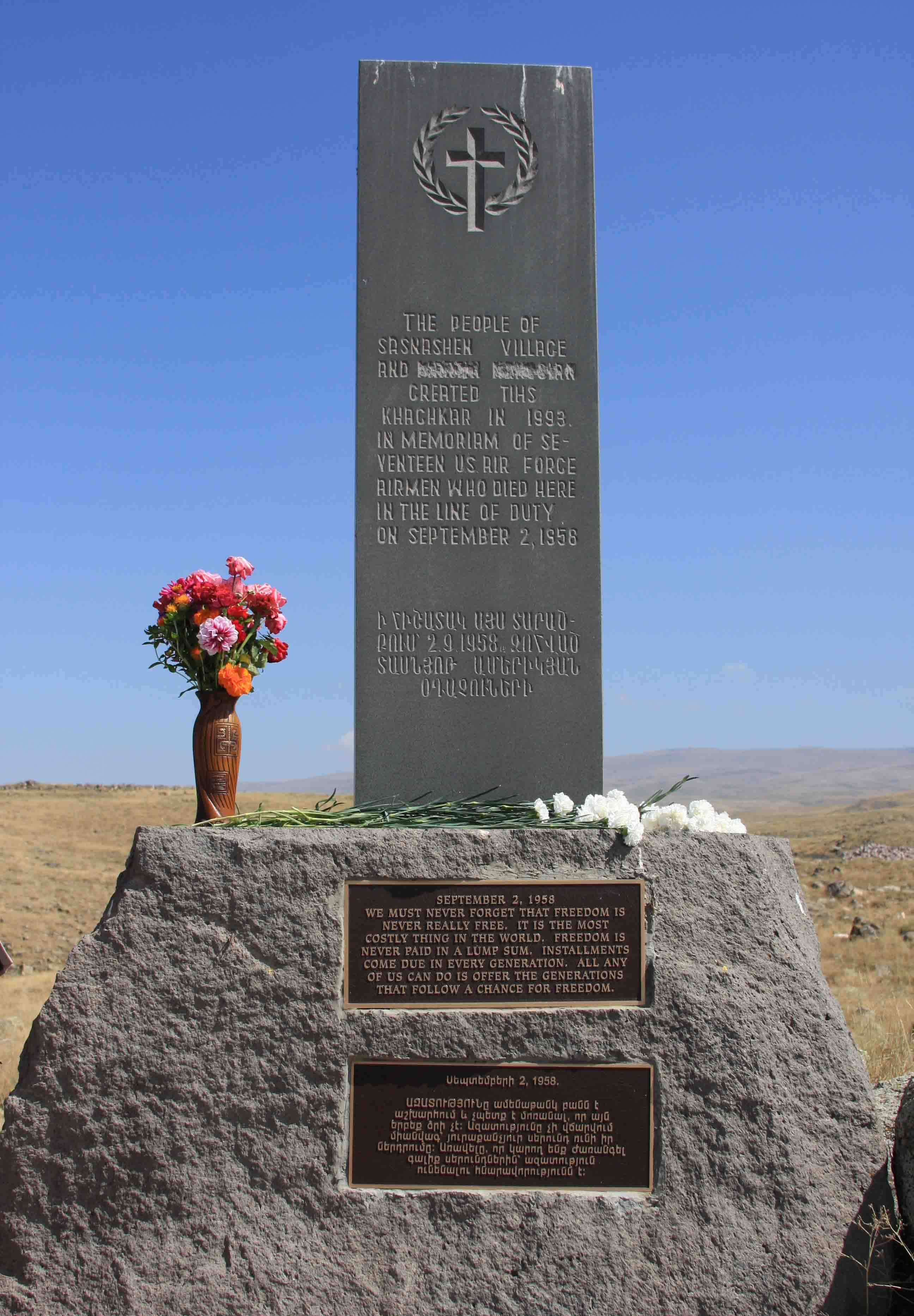Aircraft Hill C-130 Memorial
Details:
On a rocky hill outside of Sasnashen, Armenia.
Erected in 1993, the memorial is a gray stone Khachkar (traditional Armenian cross-stone) atop a rough-hewn base mounted with two bronze plaques with Armenian and English text.
Commemorates the crash of a USAF C-130 flying from Germany on September 2, 1958. 17 airmen were killed when their unarmed plane strayed into restricted airspace and was shot down by four Soviet MIG-17 fighters. The SIGINT C-130, based at Rhein-Main Air Base Germany, departed Incirlik on a reconnaissance mission along the Turkish-Armenian border. It was to fly from Adana to Trabzon, turn right, and fly to Van. From Van, the pilot was to reverse course and orbit between Van and Trabzon. This course would parallel the Soviet frontier, but the aircraft was not to approach the border closer than 100 miles. The aircraft’s crew reported passing over Trabzon at an altitude of 25,500 feet. What happened next is unclear. The C-130 crew may have become disoriented by Soviet navigational beacons which were on frequencies similar to those at Trabzon and Van--one signal in Georgia was stronger than that in Trabzon. The airplane strayed off course and entered Soviet airspace over Armenia. Soviet Air Force MiG-17 fighter planes intercepted the Hercules. The Hercules was shot down 34 miles northwest of Yerevan.
The Soviets returned the bodies of six U.S. airmen in September 1958. Four of the bodies were identified and turned over to their families for burial according to the wishes of their next of kin. The bodies of the two unidentified airmen were buried at Arlington National Cemetery with full military honors in February 1959. After the establishment of the U.S-Russia Joint Commission on POWs/MIAs in 1992, a U.S. team fully excavated the crash site to recover the fragmented remains of the other Airmen. Crew remains were interred on the 40th anniversary of the shoot-down in 1998, with a headstone identifying all members of the Crew at Arlington National Cemetery.
Sculptor Martin Kakosian, a college student who witnessed the event while on a field trip in 1958, later collaborated with the villagers to create the memorial. In late August 1993, Sasnashen village commemorated the 35th anniversary of the shoot-down during the unveiling of the khachkar. An identical replica to the Sasnashen monument, also carved by Kakosian, was placed at the National Museum U.S. Air Force in Dayton, Ohio to recognize ‘’flyers from all services who lost their lives during the silent war.’’
Source of photo: api.army.mil
Monument Text:
Stele text:
THE PEOPLE OF SASNASHEN VILLAGE AND [MARTIN KAKOSIAN] CREATED THIS KHACHKAR IN 1993. IN MEMORIAM OF SEVENTEEN US AIR FORCE AIRMEN WHO DIED HERE IN THE LINE OF DUTY ON SEPTEMBER 2, 1958.
NOTE: The sculptor’s name is visible on earlier photos of the Sasnashen monument, and on the replica at the National Museum of the U.S. Air Force -- but was chiseled out of the Sasnashen monument sometime before 2011.
Upper plaque text:
SEPTEMBER 2, 1958
WE MUST NEVER FORGET THAT FREEDOM IS NEVER REALLY FREE. IT IS THE MOST COSTLY THING IN THE WORLD. FREEDOM IS NEVER PAID IN A LUMP SUM. INSTALLMENTS COME DUE IN EVERY GENERATION. ALL ANY OF US CAN DO IS OFFER THE GENERATIONS THAT FOLLOW A CHANCE FOR FREEDOM."
Commemorates:
People:
Units:
6911th Radio Group Mobile
7406th Support Squadron
United States Air Force
Wars:
Cold War

